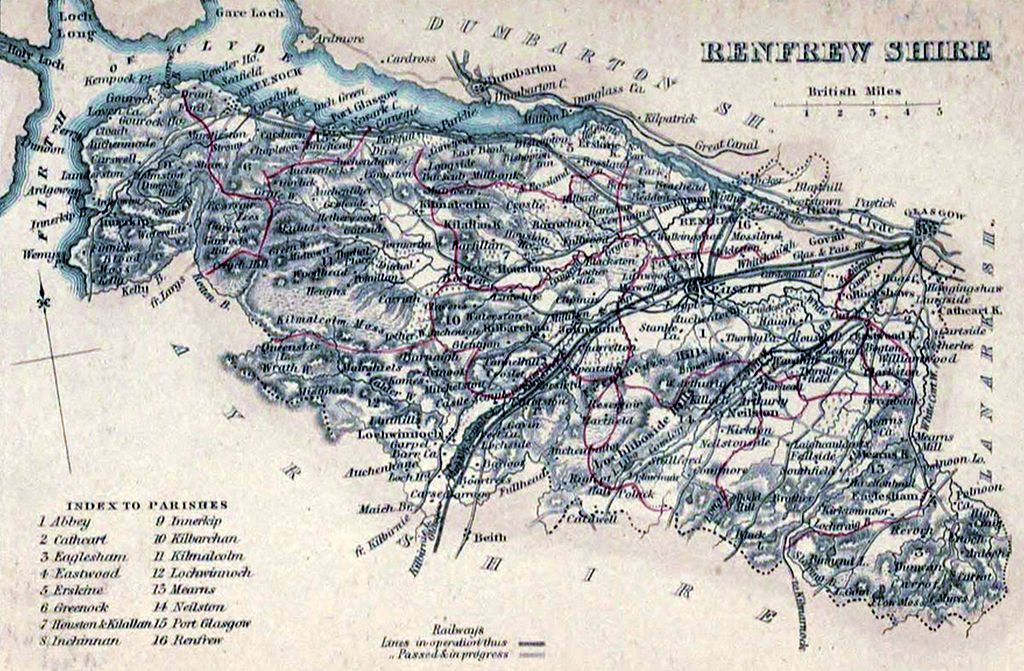Renfrewshire

By The Imperial Gazetteer of Scotland. Vol.II. by Rev. John Marius Wilson [Public domain], via Wikimedia Commons
This website is hosted by Nathan Zipfel
Please contact me if you have any questions about Renfrewshire.
History
The modern county is a political unit. It is the division of a kingdom administered by a sheriff, and this system dates back at least as far as the reign of David I (1124-1153). All such divisions may be called counties, but only to some of them can the name shire be applied. Caithness and Sutherland, for example, are counties but not shires, while Renfrew may be called either shire or county. An explanation of the names makes this distinction clear. The word shire is said to be allied to share and shear, and consequently to the Anglo-Saxon seeran - to cut. It would, therefore, mean a piece cut off. Professor Skeat, however, now derives shire from Anglo-Saxon scirian to distribute and appoint. The shires were portions of a kingdom that were originally governed by the great earls of the country, who, in many cases, took their titles from the districts they ruled. Renfrewshire was a part of the old kingdom of Strathclyde. When William I conquered England, many English earls were dispossessed of their lands, which were given to William's companions or comites. Each district was, therefore, called a comitatus, or, in its French form, comte, from which we get the word county. The counties of Caithness and Sutherland were in the hands of the Scandinavian Earls of Orkney (whence the name Southern Land) until the end of the twelfth century when they were subdued by William the Lion. When they became attached to the kingdom of Scotland, the Norman terms were already in use, and therefore, the Anglo-Saxon name did not apply to them.
Although the counties are divisions administered by the sheriffs of a king, their evolution has been a complex process. They are the final results of a long series of adjustments between different forces. The king, the church, the nobles, and, in modern times, the burghs were centers of segregation that tended to group the community in different ways. Thus, it happens that there is still a considerable amount of overlapping and confusion in the administrative divisions, not only of Renfrewshire but of all the counties of Scotland. Yet, working through all these discordant forces, the geographical factor is visible. The physical characteristics of a district have directed the other forces and molded the political divisions in harmony with natural regions. Renfrewshire is a good example of this fact. It is hardly as complete a geographical unit as Lanarkshire, which comprises the upper and middle Clyde basin, but its boundaries have a well-defined geographical basis. The point at which a large river becomes too wide to be bridged is important. The stream of traffic down the valley divides here, and the upriver trade coalesces at this point. Hence, a large town often grows up at such a place, and counties often terminate at this place. Such is the case with the Clyde. Lanarkshire ends just where the river becomes too wide to be bridged conveniently. Above this point, the banks of the river are embraced by one county. Below it, the river forms the boundary between Renfrew and Dumbarton.
The southern boundary is also, in the main, a natural one. A broad ridge of flat-topped, volcanic hills runs from southeast to northwest, separating Lanarkshire from Ayrshire. A continuation of the same ridge separates the latter county from Renfrewshire. The ridge is broken through by the Loch Libo Valley and by the Lochwinnoch Valley, but it keeps on its course and reaches its highest point in Hill of Stake on the borders of Renfrew and Ayr. The eastern boundary is a compromise between Lanark and Renfrew, in other words, a line approximately separating the middle from the lower basin of the Clyde.
Originally, there was no such separation. Lanarkshire and Renfrewshire were one. William Hamilton of Wishaw, writing about 1710, tells us that "The shyre of Lanark was anciently of greater extent than now it is; for there was comprehended in it the whole sheriffdome of Ranfrew, lying laigher upon Clyde... untill it was disjoyned therefra by King Robert the Third, in anno 1402." Since then, the changes in the boundaries of Renfrewshire have been geographically of little importance. Twenty years ago, the Boundary Commissioners transferred certain areas from one parish to another, in some instances from one county to another, in order to rectify anomalies of administration, but these changes were not of great importance save from the administrative point of view. The name Renfrew is said to be derived from rhyn a point of land, and frew - the flowing of water; there are, however, other explanations of the word. The district was formerly called Strathgryfe from the name of one of its most important rivers.
Mort, Frederick. Renfrewshire. Cambridge: University Press, 1919.
Queries and Surnames
Submit and View Queries and Surnames Submit a Query or Surnames for your lost Renfrewshire Scotland ancestor. Please use the linking feature only for genealogical material otherwise your query may be deleted.
